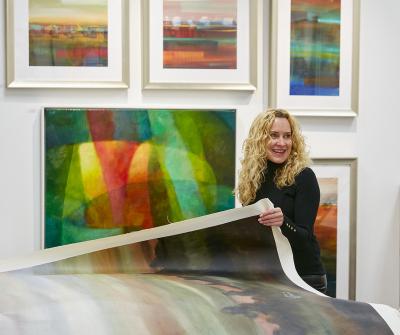Finding the right kind of artwork for a hotel could be considered an art form in and of itself. Cheryl Heisterberg, president at Atlanta-based DAC Art Consulting, has been helping hotels find their artistic style for decades.
Heisterberg co-founded the company in 2009. Today, DAC's 100,000-square-foot Atlanta studio manages a variety of artistic processes, from printing and framing to crafting pieces by in-house artists. The facility also includes a fabrication studio and gallery space for team gatherings.
Becoming Part of the Narrative

Art consulting has significantly evolved over the years, according to Heisterberg. Today, consultants engage in projects much earlier in the process, often working closely with owners, brand leaders, architects and designers in the initial stages. “Artwork used to be the last element in the design process, often even an afterthought,” she said, recalling how some pieces would not have a firm location and would be moved around and used to fill in empty spaces.
“Today, artwork is more integrated into the narrative. Every brand has a story and as art consultants, we've really learned how to execute that story." The process has become highly collaborative. Consultants work with the other members of the project development team to align the selected art with the project's design narrative, reflecting the brand's story and ownership's vision. “It's not just decorative anymore, it's part of the story.”
Design narratives have also transformed in recent years. “They've gotten so targeted that creating art programs around these really strong narratives is really exciting,” Heisterberg said.
The Process
DAC's resourcing team, led by Chief Curator Jessamy McManus, oversees a database of more than 16,000 artists who have submitted their work for consideration. When DAC secures a project, a kickoff meeting is held with both consultants and the resourcing team. “We start brainstorming artists and narrow it down based on the needs of the project, usually offering a handful of options per location.”
To support their selections, the resourcing team provides detailed justification for the recommendation of any artist for a project. “They curate pieces that align with both the budget and narrative of the project.” Once the artwork is chosen, the team decides on the display method. Heisterberg emphasized that the fabrication process often requires intricate product engineering. DAC’s flatbed printer plays a key role by enabling custom image printing on various surfaces, from mirrors and wood to specialty items such as plates and guitars. Heisterberg noted that hotels increasingly seek “overscaled” and “dramatic moments” to capture guests' attention as they enter. “Designers don't want traditional framed art as much as they used to. They’re looking for something dimensional and interesting.”
eisterberg also highlighted a growing interest in fiber-based artwork, which extends beyond ropes to encompass various textiles. While fiber has traditionally served practical purposes like quilting, needlepoint, knitting and weaving, contemporary artists are elevating it to fine art. “We see artists using thread as both paint and sculpture. They transform tiny strands into oversized wall installations that are extra impactful.”
